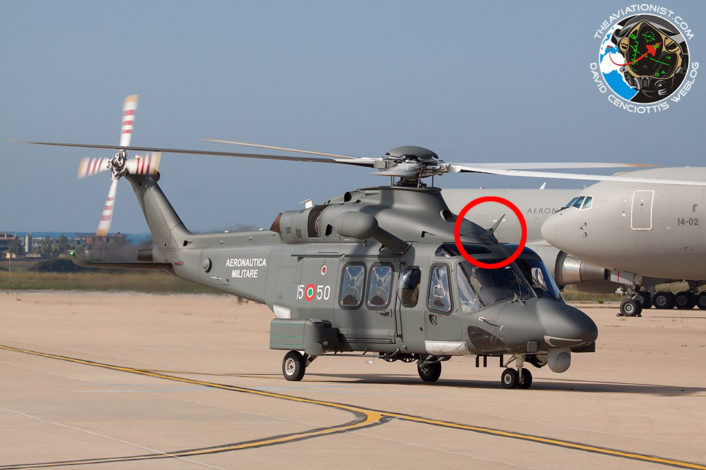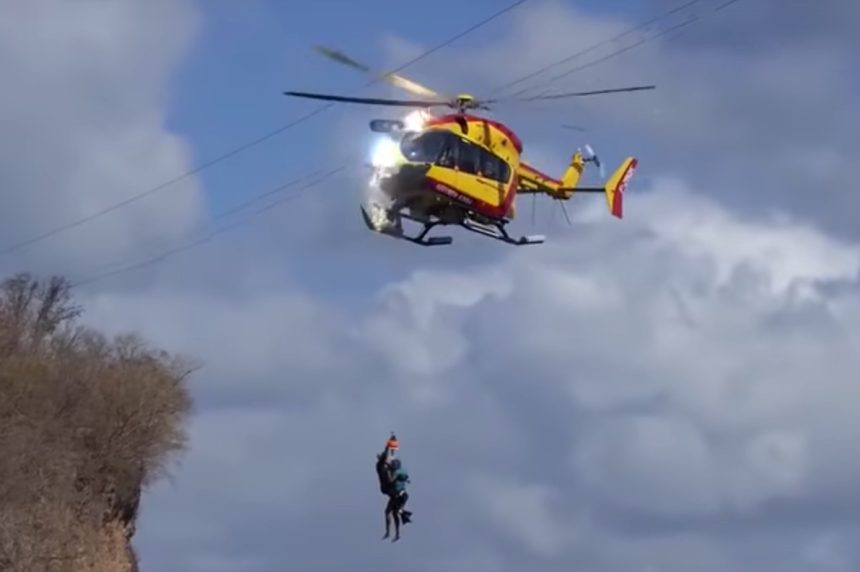Wires represent a serious hazard to both helicopters and airplanes flying at low altitude.
The following footage was filmed on Apr. 3, 2019 near Fond Bellemare, west of Fort-de-France, Martinique, an insular region of France located in the Lesser Antilles of the West Indies in the eastern Caribbean Sea.
A Eurocopter EC145 (BK117C-2) of Sécurité Civile, the civil protection branch of the French Government, hit the power lines during a rescue operation: the helicopter, registration F-ZBQK, callsign “Dragon 972”, had just winched up a person from the sea, some 200 meters from the shore. With the rescuer and a person hanging on the winch some 5 meters below, the helicopter flew into the coastal power lines.
As the video shows, while focusing on the rescue, the pilot did not see the three high voltage lines in fron of the helicopter. The EC145 hit the lines generating sparks around the radar dome and the winch-housing. The flight engineer immediately cut the winch-cable causing the rescuer and the person to fall into the sea, not far from the rocks. Fortunately, both swimmed safely to shore.
Power lines, cableways and any other kind of aerial wires below 500 feet AGL (Above Ground Level) and in mountain regions in any airspace below 500 feet above the highest ridgeline, represent a significant hazard for all kinds of aircraft. Actually, the majority of accidents involving wires occur at or below 50 feet AGL, and are due to the pilot judgement/actions or loss of situational awareness.
Wire strikes have been a matter of concern for both civil and military helicopters. Devices to protect the helicopter in case of wire strikes (such as the cable cutters) have been available for some years. Systems that warn the pilots on the proximity of wires have also been developed. In spite of
these developments, wire strikes occur every now and then. Sometimes with tragic results.
Years ago, the FAA made an analysis of both civil and military accidents involving helicopter wire strikes for the period 1994 through 2004. According to that study, wire strikes accounted for about 5% of all civil and military helicopter accidents.
Wires are dangerous no matter the experience of the pilots flying in their vicinity. A study into the aerial wire hazards published in 2012 highlighted that the average wire accident pilot had 7,225 hrs total, 5,230 FH on rotorcraft and 1,816 FH on that specific helicopter model.
A number of protection systems have been developed and made available to the helicopters all around the world to mitigate the impact, of wire impact. One system that equips most of modern military helicopters offering a degree of protection to the helicopter in frontal impacts is the WSPS (Wire Strike Protection System), whose typical installation consists of a roofmounted cutter and one or more cutters mounted on the fuselage of the helicopter. A deflector running vertically along the middle of the windshield guides the cables into the cutters.

Other systems used to mitigate the risk of wire strikes are Powerline detectors, that sense the electromagnetic fields surrounding power lines and uses this information to alert the pilot to the proximity of wires; Radars, thattransmit a 35-GHz radio frequency for detecting obstacles in the flight path; Laser Obstacle Awareness Systems, that use laser to detect wires and feed these data into the aircraft’s targeting, control, display, or navigation systems; GPWS (Ground Proximity Warning Systems) updated with obstacle data; and Obstacle Collision Avoidance Systems located on utility and power line towers (they detect all air traffic entering a predefined warning zone and activate warning lights that illuminate the tower as well as radio calls).
H/T to @Fox_RomeoFox for the heads-up!








